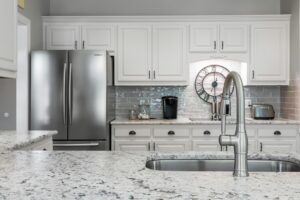Types of Kitchen Sinks
When choosing a kitchen sink, you have several types to consider. The design and layout of your kitchen can help determine which one is the best fit.
Top-Mount Sinks
Top-mount sinks, also known as drop-in or self-rimming sinks, are mounted directly on top of the countertop with their rim overhanging the counter surface. This type is straightforward to install and works well with any kind of countertop material.
Undermount Sinks
An undermount sink attaches beneath the countertop. This style provides a seamless look between your counter and sink, making it easy to swipe crumbs straight into the basin without them getting caught on an exposed lip like they would in a top-mount model.
Farmhouse Sinks
Farmhouse or apron-front sinks feature large forward-facing sections that replace part of the counter. These models make washing large pots easier by reducing strain from reaching over cabinets into deep basins.
Corner Sinks
If you have limited space or an unusual layout in your kitchen, corner designs may be perfect for you. As suggested by their name, these units fit perfectly into corners, maximizing available space effectively.
Bar Sinks
Bar sinks, also known as prep sinks, are secondary small basins usually installed alongside main ones. They’re ideal for preparing food items away from dirty dishes in primary basins or filling pots without moving around too much.
Materials Used in Kitchen Sinks
Different materials offer varying levels of durability, aesthetics, maintenance requirements, and costs:
Stainless Steel
Stainless steel models dominate kitchens worldwide due to being lightweight yet robust, resisting chips, stains, and rust well. They are also affordable compared to other options available.
Cast Iron
Cast iron variants boast remarkable longevity thanks to a porcelain enamel finish that imparts an attractive glossy look while shielding the underlying metal against damage, thereby maintaining a pristine appearance even after years of constant usage.
Fireclay
Fireclay resembles cast iron but is even more durable. It’s created by molding ceramic clay into the shape of a sink and firing it at very high temperatures, resulting in a material that withstands heat and heavy use.
Copper
Copper sinks possess antimicrobial properties besides a unique rustic charm that improves with age as a natural patina develops over time, enhancing the overall visual appeal of the kitchen.
Granite Composite
Granite composite blends crushed granite or quartz with resin fillers, producing a highly resistant, hard-wearing option that gives a luxurious look to kitchens while tolerating heat exceptionally well.
Choosing the Right Sink for Your Kitchen
Selecting an appropriate kitchen sink involves considering multiple factors:
Assessing Your Kitchen Size
Larger kitchens can accommodate bigger or double-bowl sinks, whereas smaller ones may only allow small single-bowl units.
Considering Your Cooking and Cleaning Habits
Those frequently washing large pots and pans might prefer deep basins or farmhouse designs, while others who cook less often may find top-mount models sufficient.
Matching the Sink with Your Kitchen Decor
Different materials and colors suit varying themes: Stainless steel works seamlessly in modern minimalist setups, while copper or farmhouse models fit perfectly in traditional rural-style interiors.
Budget Considerations
Higher-end materials like copper or fireclay tend to cost more compared to stainless steel or cast iron counterparts, so choose according to budget constraints.
Installation of Kitchen Sinks
Kitchen sinks can be installed professionally or DIY if you have adequate knowledge and the right tools on hand:
Professional Installation
Professional plumbers guarantee precise fitment and ensure all connections are secure, thereby reducing potential leaks or problems later down the line.
DIY Installation
A DIY approach helps save professional fees, though it requires the necessary skills, tools, and ample patience to ensure things go smoothly without hitches caused by errors during the process.
Necessary Tools for Installation
Commonly required tools include measuring tape, level, hacksaw or jigsaw (for cutting countertop holes), wrenches, plumber’s putty or caulk, and safety equipment like gloves and goggles.
Safety Measures During Installation
Always cut carefully to avoid injury, making sure not to damage surrounding areas or countertops. Additionally, confirm all connections are securely tightened to prevent leaks.
Maintenance and Cleaning of Kitchen Sinks
Regular cleaning and maintenance help prolong your sink’s lifespan:
Regular Cleaning Tips
Daily rinsing after use, combined with weekly deep cleaning using appropriate cleaners, ensures stain-free, sparkling sinks.
Dealing with Common Issues Like Clogs and Leaks
Unblocking clogged drains is usually possible by using plungers or chemicals, or calling professionals when necessary. Fix minor leaks immediately to prevent them from escalating into bigger problems.
When to Call a Professional for Help
Major repairs or issues like persistent leaks, clogs, or sink replacements are best left to experts due to their complex nature, requiring specialized skills and tools.
Environmental Considerations
Eco-conscious homeowners will appreciate these environmental considerations:
Water-Saving Features
Faucets equipped with aerators reduce water flow, thereby saving precious resources without compromising performance.
Energy-Efficient Models
Insulated units minimize heat loss from hot water, helping save energy costs over time, especially for electrically heated ones.
Sustainable Materials
Sinks made from recycled content contribute towards sustainable living while reducing carbon footprints significantly.
Future Trends in Kitchen Sinks
Modern kitchen sinks incorporate various innovative features aligning with the latest trends:
Smart Sinks
Smart designs come with built-in sensors that automatically control water flow (touchless operation), maintaining hygiene while conserving water effectively.
Multifunctional Sinks
Multifunctional units integrate cutting boards, drying racks, etc., improving efficiency by catering to diverse needs seamlessly within the same space, ensuring maximum utility for each inch of available area.
Eco-Friendly Designs
Eco-friendly options are increasingly popular as they utilize green production methods and materials, reducing overall environmental impact while delivering excellent functionality and style simultaneously.
Making the Most of Your Kitchen Sink
Maximize your kitchen sink’s functionality, enhance aesthetics, and ensure longevity with these tips:
Maximizing Functionality
Choose double-bowl designs or add accessories like colanders or basket strainers to improve utility.
Enhancing Kitchen Aesthetics
Pick a model that complements your kitchen décor and theme, creating harmonious, appealing visuals.
Ensuring Longevity and Durability
Invest in high-quality, durable materials to ensure long-lasting performance. Regular maintenance and cleaning are also crucial for prolonging the lifespan.
FAQs
Q: How often should I clean my sink? A: Daily rinsing after use along with weekly deep cleaning is recommended to maintain hygiene and prevent stain buildup.
Q: Which material is best for sinks? A: Each material offers unique benefits, so choose one that suits your personal needs and preferences. Stainless steel remains popular for its affordability and durability, while cast iron and fireclay provide premium alternatives.
Q: Can I install a sink myself? A: Yes, you can if you have the necessary skills, tools, and time; however, professional installation guarantees precision and secure connections, reducing future issues or problems.







